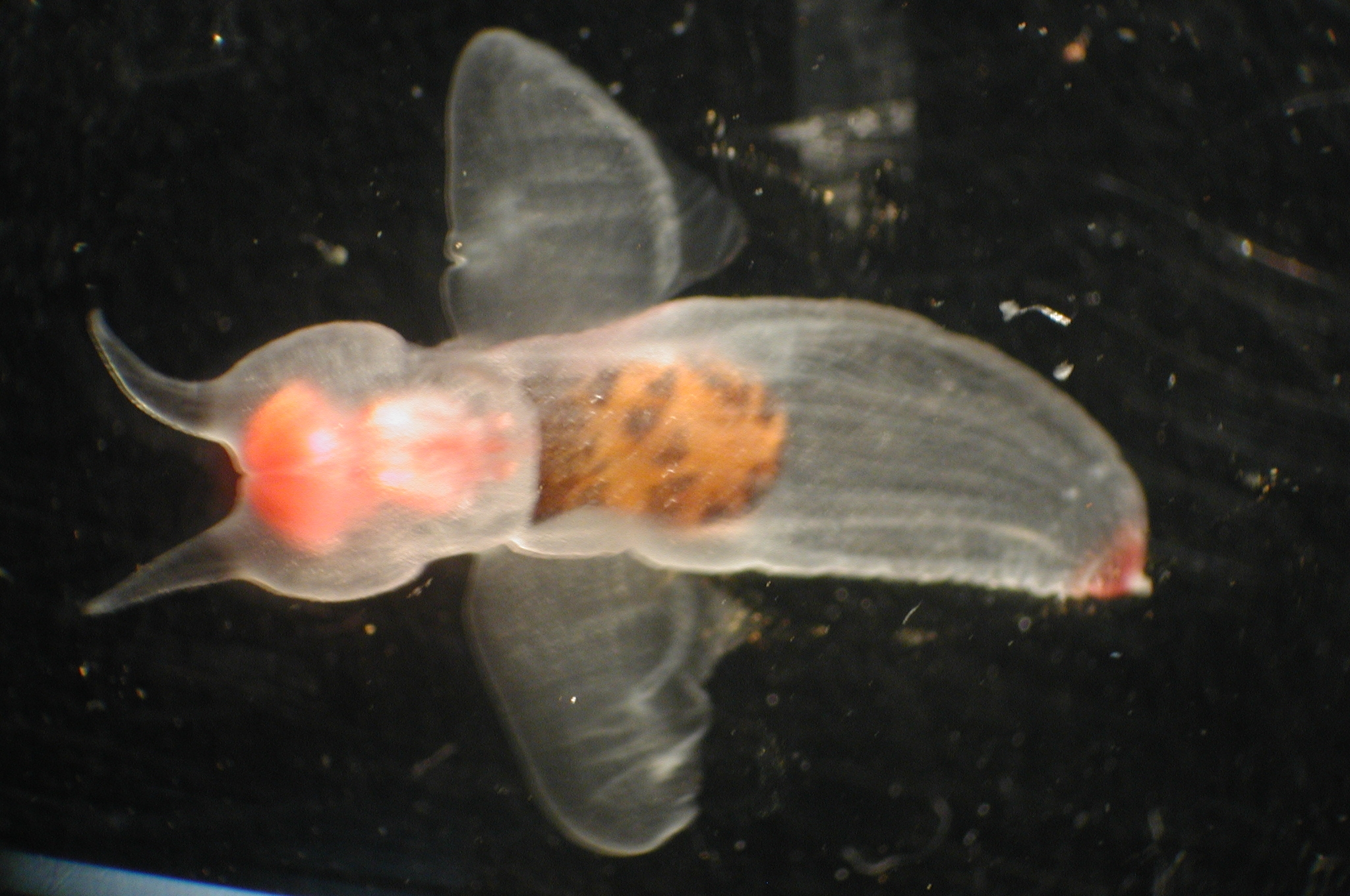- Sea angel
Taxobox
name = Sea angel

image_width = 240px
image_caption = "Clione limacina"
regnum =Animal ia
phylum =Mollusca
classis =Gastropoda
subclassis =Orthogastropoda
superordo =Heterobranchia
ordo =Opisthobranchia
subordo = Gymnosomata
subdivision_ranks = Families
subdivision =
*Clionidae
*Cliopsidae
*Hydromylidae
*Laginiopsidae
*Notobranchaeidae
*Pneumodermatidae
*Thliptodontidae Sea angels, also known as cliones, and previously known as one kind of
pteropod , are a group of small swimming seaslugs .These are
pelagic marineopisthobranch gastropod mollusk s in the suborder Gymnosomata within the superorderHeterobranchia .The number of families defined within this order varies from one taxonomist to another, but there may be as many as eight families and 17 genera. In the new taxonomy of Bouchet & Rocroi (2005), the
clade Gymnosomata is arranged as follows :
*Superfamily Clionoidea : family Clionidae, family Cliopsidae, family Notobranchaeidae, family Pneumodermatidae
*Superfamily Hydromyloidea : family Hydromylidae, family LaginiopsidaeThliptodontidae is then treated as Thliptodontinae, a subfamily of the family Clionidae.
Description
In this suborder the foot of the gastropod has developed into wing-like flapping appendages ("parapodia") and their shells have been lost. These are both adaptations which suit their free-swimming oceanic lives. The adaptations also explain the common name "sea angel" and the
New Latin name of the order; from "gymnos" meaning "naked" and "soma" meaning "body."The other suborder of pteropods,
Thecosomata , are superficially similar to sea angels but are not closely related. They have larger, broader parapodia, and most species retain a shell; they are commonly known assea butterflies .Sea angels are gelatinous, mostly transparent and very small, with the largest species ("Clione limacina") reaching 5 cm. "Clione limacina" is a polar species; those found in warmer waters are far smaller. Some species of sea angel feed exclusively on sea butterflies; the angels have terminal mouths with the
radula common to mollusks, and tentacles to grasp their prey, sometimes with suckers similar tocephalopod s. Their "wings" allow sea angels to swim much faster than the larger (usually fused) wings ofsea butterflies . Other species of sea angel feed mostly onzooplankton .Another large polar species of sea angel, "Clione antarctica", defends itself from predators by synthesizing a previously unknown molecule, named "pteroenone". As predators will not eat the sea angel some animals, such as
amphipod s, take up home inside them. Local population density of "Clione antarctica" may reach claustrophobic levels; up to 300 animals per cubic metre have been recorded.Life habits
Slowly beating their parapodia, sea angels gracefully fly through the upper 20 metres of the water column. Although usually slow-moving, they are capable of surprising bursts of speed.
The animals are simultaneous
hermaphrodite s, and fertilization occurs internally. A gelatinous egg mass is released during spawning, and the eggs float freely until hatching. Their embryonic shells are lost within the first few days after hatching.urvival threats
The
IPCC reports that increasing atmospheric carbon dioxide is causing acidification of the oceans, which could eliminate pteropods from the Southern Ocean and cause serious repercussions throughout thefood chain . [ [http://www.gtp89.dial.pipex.com/FGD/Ch15.pdf 2007 IPCC Working Group II Report on Polar Impacts] ]Note
References
Books
* "Mollusca - The Southern Synthesis" Order Gymnosomata by L. Newman pages 985-989; Beesley, P.L., Ross, G.J.B. & Wells, A (eds) - ISBN 0-643-05756-0
External links
* list of Clione entries in the Sea Slug Forum: [http://www.seaslugforum.net/search.cfm?searchstring=Clione]
* [http://www.fmnh.helsinki.fi/users/haaramo/Metazoa/Protostoma/Mollusca/Gastropoda/Opisthobranchia/Gymnosomata.htm Mikko's Phylogeny Archive]
* [http://mollus.oxfordjournals.org/cgi/content/abstract/71/2/113?maxtoshow=&HITS=10&hits=10&RESULTFORMAT=&fulltext=Gymnosomata&searchid=1134298245194_3&stored_search=&FIRSTINDEX=0&journalcode=mollus Reconstruction of the phylogeny of Opisthobranchia; Journal of Molluscan studies]
Wikimedia Foundation. 2010.
